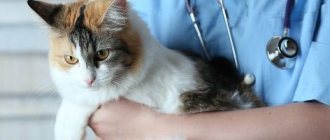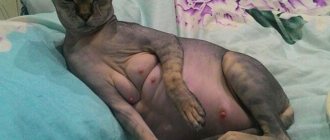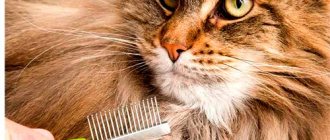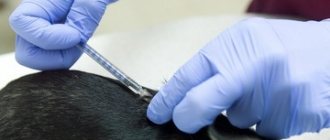During castration, the surgeon cuts the scrotum, ties the tail of the epididymis and removes the testis, after which the wound is sutured. From the description it is clear that castration of a cat is a fairly simple procedure and takes 15-20 minutes, but recovery from anesthesia can last up to 3-4 hours.
Methods, methods of castration
In modern veterinary medicine, there are various castration techniques. The types of castration methods are divided according to the degree of intervention. The most common of them are open and closed methods. In addition, there are techniques in which parts of the pet’s genital organs are not removed.
- Surgical methods
of intervention:
- Bloody. Classic manipulations - open, closed. The open method is the main one. In this way, the testes are removed using scissors. The closed method involves cutting only the skin.
- Bloodless. This method involves castration by destroying the vas deferens, the epididymis or the entire testis. Vasectomy is a sparing method. During the procedure, the pet's blood vessels and nerves are not affected; the vas deferens are partially destroyed.
- Castration by irradiation.
The cat's sexual activity is reduced due to the effect of radiation on the testes and appendages. Although this method is non-surgical, it can cause the development of cancer in the animal. - Chemical castration.
The pet is either given a special injection or given pills that suppress sexual desire. - Chemical castration on implants.
The technique is expensive, but allows you to restore reproductive capacity in the future. The implant is injected into the cat’s skin, which reduces sexual desire after 6 weeks for a long time. - Castration-microwave
. Irradiation with microwave rays guarantees the result forever; anesthesia is a necessary condition for this procedure. The method has been proven in agriculture, but has not gained popularity in veterinary medicine. The procedure requires a microwave emitter, and the consequences have been little studied.
Traditional methods of surgical castration of cats remain popular in veterinary clinics.
Anatomical data
The scrotum is a bag of skin, muscles and other tissues. The outer layer of the “bag” is represented by the dermis, the inner layer by the muscular-elastic layer and fascia. The top of the scrotum is covered with thin, small hairs; the dermis contains sweat and sebaceous glands. The muscular-elastic membrane divides the scrotum into left and right halves through the median septum.
The external levator testis grows into the outer layer of the common tunica vaginalis and is isolated from the scrotum by the levator fascia. Therefore, when the sac is cut during castration, the common tunica vaginalis, together with the external levator, is very easily detached.
The common tunica vaginalis is created by two fused sheets:
- The outer fibrous sheet is attached to the scrotum through its fascia.
- The inner serous leaf is attached to the epididymis by means of a transitional ligament.
Thus, a cavity of the common vaginal membrane is formed between the testis and the scrotum. The area that covers the inguinal canal is called the parietal vaginal canal. In all mammals, the cavity of the common tunica vaginalis has access to the abdominal cavity through the vaginal canal.
The inguinal canal is an opening in the groin area near the pubic bone, midway between the external and internal oblique muscles. It contains the external levator, external pudendal arteries and veins, the external spermatic nerve and the vaginal canal.
The inguinal canal originates from the abdominal internal ring-opening and ends with the external subcutaneous opening. The external inguinal ring is located in the tendon plate of the external oblique muscle between its abdominal and pelvic plates. The internal abdominal ring is located near the pubic bone, it borders cranially with the pelvic part of the internal oblique muscle, and caudally borders with the inguinal ligament.
A pair of testes with appendages is located in the cavity of the common vaginal membrane. They distinguish between head (lower) ends and tail (upper) ends. At the lower end there is the testis itself and the head of the epididymis, the upper end is formed by the tail of the epididymis.
The spermatic cord is formed by the fold of the internal mesentery of the testis; it contains vessels, nerves, the internal levator of the testis and the vas deferens. In the anterior part, the cord creates a vascular weave. The scrotum in cats is located between the thighs closer to the anus behind the ischial bones.
Recommended castration age
Kittens can be sterilized from two months of age; the risk of complications and bleeding is low. Two- or three-year-old cats can only be sterilized under general anesthesia, since local anesthesia can be ineffective. The optimal age for defermenting a pet is from six to twelve months, but not later than seven years. During this period, sex hormones do not have a significant effect on the development of the cat’s body, while the condition of the genital organs is ideal for performing the procedure.
Local anesthesia is required in this age category, rehabilitation is quick. Also, the time that is considered ideal for performing surgical procedures is determined according to the breed, physiological state of the pet, and individual characteristics. British and Persians, for example, are considered high-risk breeds. It is best to neuter them between 8 months and a year.
The age category is not a limitation if the cat suffers from any ailments or if the owners have not decided on surgery for a long time and the animal is more than seven years old. The operation can be performed, but, in any case, the veterinarian will conduct an examination and, if necessary, prescribe tests.
Goal No. 2. Out of pity.
Out of pity, we castrate them... That is. Imagine your husband, who needs to “fast”... well, let's say... 1/3 of his life, i.e. about 20 years!!!! IN! How will his face change? A!!! So there you go! And this is exactly what we condemn the cat to in city apartments!!!!! Castration is our price for domesticating cats. Therefore, convince your husbands, ardent supporters of “fullness” to be in solidarity with the cat and feel sorry for him... Otherwise, see point 1: he will start shitting in the shoes of the protector and the authority and the head of the family, so he himself will call the doctor!
And here some opponents come to point 3...
Why is this needed? Pros. Cons and contraindications
Sterilization of felines is resorted to in order to stop or suspend reproductive function. The production of male hormones stops and, as a result:
- the cat stops screaming at night;
- aggressive behavior is replaced by affectionate behavior;
- The problem of territory marks and unpleasant smell in the apartment is solved.
- Veterinarians note other positive aspects of surgical intervention:
- the life expectancy of a neutered furry friend is 1.5-2 years longer;
- the search for the cat ends;
- exclusion of diseases such as adenoma, prostatitis, breast and anal gland tumors;
- the pet becomes balanced, obedient, and does not get into fights.
Among the disadvantages are laziness and a sedentary lifestyle, which results in obesity and related problems. Urolithiasis is also possible. To avoid these manifestations, you should adjust your diet. Anesthesia also carries some risk, especially for older cats. In addition, surgery may be accompanied by complications. It is important that the procedure is carried out by an experienced, qualified and responsible doctor.
Surgical manipulations for the purpose of defertility are prescribed only to healthy males. In veterinary medicine, the following contraindications are identified:
- liver, kidney failure;
- cardiovascular diseases;
- anemia;
- epilepsy;
- respiratory diseases, including bronchial asthma;
- exhaustion of the body;
- time before scheduled vaccination 14 days;
- 30 days have not passed from the date of the last vaccination.
In order to minimize risks, veterinarians do not recommend castrating cats younger than 7 months and older than 8 years.
At what age should I do it?
When can a cat be neutered? The optimal time recommended by experts is 3-4 weeks before puberty. So at what age is it better to castrate a cat? It all depends on the breed: Abyssinians, Burmese and other oriental breeds mature earlier - by 5 months, other cats reach the optimal age by 7-8 months.
Castration too early is undesirable for the reason that before the onset of puberty, the genitourinary system of cats is still developing.
Preparing the animal for surgery
Owners of a cat who is going to be neutered should remember some rules:
- the pet must be healthy, without external signs of disease;
- before the operation, the furry friend must be examined by a specialist and prescribed general and biochemical blood and urine tests;
- It is also advisable to undergo an examination by a cardiologist: it is necessary to exclude the possibility of pathologies of the heart muscle and heart diseases;
- ten hours before the procedure you cannot feed or drink the cat.
For sterilization, you will need a veterinary passport, a device for transporting a furry friend (preferably with a convertible top), a warm blanket, a disposable diaper as bedding, and napkins.
The veterinary clinic will require proof of vaccinations and deworming. In some cases, it is allowed to defertilize an unvaccinated animal using a special medicine. The presence of vaccination reduces the risk of developing dangerous infectious diseases, as it develops immunity.
Treatment against worms before castration is carried out unscheduled ten days before the procedure.
Contraindications for carrying out
Castration is performed under general or local anesthesia. Not all cats are able to tolerate anesthesia due to age, the presence of certain diseases, or allergies to medications. The first thing you need to know before the procedure is whether your pet has an allergic reaction to the drugs and whether his heart is able to function normally during the procedure. To establish possible contraindications for the intervention, the cat must first be examined by a veterinarian. Permission is given after analyzing the results obtained.
Anesthesia
The operation is performed under general anesthesia. Veterinary clinics use the inhalation method, intramuscular and intravenous injections, and gas anesthesia for anesthesia.
The latter has no side effects, does not cause pain and does not have any side effects on the body. In addition, the supply of gas anesthesia is controlled during the period of manipulation: the concentration of the drug can simply be reduced or increased. With this type of anesthesia, your pet can be quickly brought out of this state.
The drugs used for anesthesia are determined by the doctor depending on the general health of the animal and other indicators. Under anesthesia, the cat sleeps, does not perceive pain, his consciousness is turned off and his muscles are relaxed. The selection of drugs is carried out individually in veterinary clinics. Intravenous anesthesia is considered the most effective.
The substance acts quickly and has no side effects on the heart and lungs. The intramuscular method has an affordable price and is considered traditional. Inhalation, in comparison with other methods, is more complex and expensive, and is rarely used.
Anesthesia
The operation can be performed under local anesthesia with infiltration and conduction injection of 0.25-0.5% novocaine in the lateral position. But more often it is done under general anesthesia with the cat secured on the back with its paws to the sides (so that nothing interferes).
There is always a risk of death of the animal due to anesthesia if the dosage is exceeded. In young animals, the likelihood of death is minimal, but in cats over 7 years of age, the risk of death increases sharply. Also, British breeds, Maine Coons, and Scottish Folds have a predisposition to an excessive reaction to anesthesia. It is dangerous to anesthetize animals with heart defects or insufficiency.
All drugs can be divided into 2 large groups:
- For intravenous injection.
- For intramuscular and subcutaneous administration.
In most cases, an intramuscular injection of Xylazine is used. But recently, intravenous injection of Propofol has become increasingly popular. For aggressive cats, the use of Medetomidine and Zoletil is recommended.
Please note that the use of Xylizin, Propofol and other anesthesia drugs do not provide real pain relief. That is, the animal is simply immobilized due to muscle relaxation; at best, consciousness disappears, but there are situations when the patient feels everything. Therefore, in some clinics, anesthesia is combined with local anesthesia with lidocaine.
Xylazine
Advantages:
- Easy to administer.
- The cat is less stressed.
- Lower price of the drug.
Flaws:
- Significantly reduces blood pressure.
- Reduces breathing.
- It is necessary to wait a long time, since anesthesia occurs in 5-30 minutes (depending on the method of administration).
- Absolute immobilization and relaxation are not always achieved.
- It takes a long time for a cat to come to his senses – from 3 hours to a day.
- During anesthesia, cats often vomit, which interferes with the operation.
- Negative effect on the heart muscle.
- The likelihood of intestinal atony.
- There are no antidotes to Xylazine.
Propofol
Advantages:
- Instant anesthesia (immediately upon insertion of the needle).
- Anesthesia lasts 20-40 minutes, which is quite enough for surgery.
- The animal comes to its senses within 1-2 hours (appetite and “cat-like” agility appear).
- There is no vomiting or other disturbing reactions.
- Has the maximum degree of safety.
Flaws:
- Only intravenous injection is suitable.
- The price of the drug is higher.
- It also inhibits respiratory activity.
- The fur on the paw will need to be shaved, which can be called a temporary cosmetic defect.
Procedure in stages
The operation algorithm is as follows:
- Disinfection of the operated area.
- Anesthesia. The animal is restrained and immobilized. Sedatives may be prescribed several days before the procedure. Before administering an anesthetic, veterinarians mainly carry out pre-medication prophylaxis with a special drug that prevents side effects.
- Excision of testes. A qualified specialist uses disposable instruments to remove the genitals in the traditional open manner. The male's scrotum is pulled back and each layer is cut. After exposing the testis, the spermatic cord is ligated and cut 5 mm lower. The wound surface is treated with an antiseptic. Mostly, several seams are repaired or there is no need for it at all. Elderly males are sterilized using the closed method:
- scrotal incision;
- twisting of the vaginal membrane;
- thread stitching;
- establishing a ligature;
- cutoff;
- cauterization with tincture of iodine.
Recovery from anesthesia and recovery after the intervention occurs within two to three days. The cat will feel nauseous, its movements will be uncoordinated, and the animal will need increased care.
About proper preparation of the room
Before calling a doctor to your home, the room must be prepared. Other pets should be given to someone else for a while. Children and other family members should not be present at home on this day.
It is necessary to remove carpets from the room, carry out wet cleaning, ventilate and provide high-quality lighting. A bedding should be laid on the floor, onto which the cat will then be transferred after surgery.
Caring for an animal after castration. Possible complications
The patient must stay in the veterinary clinic for the first hours. During this period, the doctor will be able to make sure that the cat tolerated the anesthesia normally. In the first postoperative hours, the following manifestations will be observed in your pet:
- dizziness;
- nausea;
- feeling of thirst;
- muscle weakness;
- dry eyes;
- low body temperature;
- unsteadiness of gait.
The pet can remain under the supervision of a veterinarian for the first 24 hours, but this will put him in a stressful state. Experienced doctors recommend taking the cat home. The pet needs attention and care, as well as painkillers. The groin area should be examined daily. To speed up the healing of the stitches, they are treated with peroxide and brilliant green.
To prevent the animal from licking the wound, you can wear a special collar that is removed when eating. Tetracycline ointment should be used for eye care. A warm heating pad will calm your furry friend and give him a feeling of comfort. Recovery after surgical procedures is easier in winter. In summer, you also need to take antibiotics.
At first, the cat's toilet should be bright so that the owner can notice the bleeding. You can wear a diaper with a hole for a tail. The first time after sterilization, animals experience a decreased appetite, then an increased one. You should give your cat enough water and monitor its diet. Your pet should not overeat.
Complications after surgery cannot be ruled out. The consequences of surgical manipulations are divided into:
- Early. Bleeding, prolapse of the spermatic cord, omentum, etc. are noted immediately.
- Late. Inflammatory and infectious pathologies develop gradually.
- Scrotal swelling and inflammation are often caused by poor sanitary and hygienic conditions. The most dangerous phenomenon is a retroperitoneal abscess. This is a secondary type of complication that occurs due to inflammation of the spermatic cord.
To avoid pathological processes, preference should be given to a proven and professional clinic.
FAQ
The upcoming operation raises some questions among the owners:
- Is it possible to feed a cat before surgery or how much not to feed before surgery? Before castration, the cat should not eat for at least 12 hours. It is better to endure anesthesia on an empty stomach; the possibility of vomiting and diarrhea after the procedure is also reduced. You can give your cat something to drink a couple of hours before castration.
- Is it possible to sterilize a cat without castration? Yes, it's possible. But this method is half-hearted. After sterilization (ligation of the spermatic cords), the tailed cat can continue to mark the territory and jump on the female, especially if the cat is “experienced” and has previously had experience in loving communication with cats.
- What is preferable: spaying or neutering a cat? It is worth noting that not all clinics carry out sterilization of cats, therefore, if you really want to sterilize (ligate the spermatic cords) of your pet, then be prepared to look for a suitable veterinary clinic and fork out some money.
How does the operation take place?
The operation can be performed either in the clinic or at the owner’s home, there is no fundamental difference. The whole procedure takes only a few minutes. Anesthesia is administered (intramuscular or intravenous). Next, the surgical field is disinfected, in our case it is the groin area. Then the scrotum is incised longitudinally to the size of the testis. The doctor removes the testis from the scrotum and tightens the spermatic cord (applies a ligature). The testis is cut off.
How to care for your pet after surgery?
After castration, blood stains and clots must be removed from the incision site once and sprinkled with an antiseptic. During the first 24 hours after surgery, the cat's condition should be closely monitored. After anesthesia, the fluffy can sleep for several hours, but after waking up he remains in an intoxicated state for some time, poorly coordinates his movements, refuses to eat, but wants to drink. For a couple of days you need to help the cat get to the toilet. Because it still hurts to move after castration. It is better not to fill the tray, so as not to expose the fresh suture to the risk of infection and decay; in extreme cases, you can put an absorbent sterile towel there. It is necessary that the cat does not lick or scratch the surgical suture. Veterinarians recommend treating the wound with brilliant green only in the area around the seam. If the suture does not heal within a few days, contact the operating veterinarian.
What should I feed my cat after surgery?
Many cat breeders criticize castration because the cat allegedly gets fat after it. But animals, like humans, gain excess weight due to poor nutrition. The menu after surgery can be simple but balanced. Boiled poultry, beef, cottage cheese, occasionally eggs, vegetables, drink plenty of fluids. If your cat is used to eating only cat food, then you should not forcefully change his diet, but reduce the portion slightly to avoid overeating. Yes, the cat will not overeat, scream heart-rendingly and demand a partner, because hormones no longer require release, and therefore no energy is wasted.
What should cats not be fed after surgery? Neutered cats are practically no different from all other cats (well, except that there are no tiny testes). Therefore, on a general basis, we do not feed food that is too fatty, salty, carcinogenic, smoked (which we ourselves love to eat), food of dubious quality, and legumes. We give exactly as much food as we gave before the operation.
Does a castrated cat live less?
As already mentioned, castrati are practically no different from others of their own kind. And life expectancy is influenced by sufficient physical activity, timely vaccinations and treatment, a balanced diet, a favorable home environment, and the absence of small children pulling the tail.
Animal behavior after the procedure
Spaying is difficult for your pet to tolerate. The behavior of a castrated cat is characterized by the following manifestations:
Anxiety in the first 5-6 hours. The animal meows after the anesthesia wears off and is tormented by headaches. Attention and affection from the owner will help make it easier to survive the post-operative period.
After this period of time, the cat will sleep a lot. Thus, the pet regains its strength.
After a few days, the cat may be shocked by the absence of genitals. To distract your pet, you need to play with it more often, talk and pet it.
If changes appear that are of great concern to you, contact the veterinarian who performed the operation. Assessing the normal level of behavior is possible only after a qualified examination.
Alternative to surgery
If you do not want to deprive your cat of the future joy of fatherhood, but cannot stand all his “surprises” associated with building a hierarchy in the house and the desire to reproduce, then you can give him a hormonal injection, which lasts about 6 months.
However, the consequences of using such drugs can be very dire and even lead to cancer in the cat.
Therefore, only an experienced veterinarian can determine whether a particular drug is suitable for your animal or not.
Author of the article: veterinarian Olga Terentyeva
Castration for diseases
There are medical indications for which castration is vital:
- prostate cancer, other neoplasms in the genital organs;
- testicular injuries;
- urolithiasis disease;
- genetic pathologies.
Among the genetic diseases is cryptorchidism. With this disease, one or both testicles remain in the groin under the skin or in the peritoneum. In a healthy animal, the ovaries extend into the scrotum. In this case, surgery is indicated. If the procedure is not carried out, the development of testicular pathologies may occur, including saminoma - an ovarian tumor. This operation is more difficult and expensive.
Sterilization and castration of cats
Castration of a cat means deprivation of furry testes. There is no need to assume that castrated cats are deprived of all the joys of life. On the contrary, after castration, the chances of dying from urolithiasis (UCD), which occurs in many cats due to hormonal fluctuations and metabolic disorders, are sharply reduced. Operated purrs live much longer than their relatives due to the stability of hormonal levels, they no longer suffer from sexually transmitted infections, and their behavior improves.
Sterilized cat - with spermatic cords tied. The method is controversial, because after this procedure the cat continues to mark the territory and your shoes, and is able to hunt cats without procreation. It is a mistake to think that a sterilized cat suffers from the inability to procreate and lack of sex. After all, even in the wild, the male still has to win his right to the female, and not everyone succeeds in this.
Advice from experts and owners
According to the advice of veterinarians, castrating a male is safe, quick and with virtually no consequences. Modern clinics offer excellent conditions for the procedure. The operation takes place within 10-15 minutes, complications are rare.
If this procedure is not carried out, the cat will mark the territory, thereby damaging the owners’ personal belongings and furniture. The way out of the situation is to send the cat for a walk outside and find the cat yourself or bring the pair home. In this case, there is a risk of a fight, as well as other negative consequences.
Owners of mustachioed pets who have undergone castration are advised to resort to the procedure. If the animal is a pet and practically never goes outside, there is no point in torturing it.
Is it necessary to neuter a cat at all?
If you have the opportunity to find a female at the first demanding “meow!”, if you are already accustomed to the pungent smell of cat marks and torn wallpaper, if there are many kind hands around you who will happily sort out the offspring, or if you have a ruthless heart and You can drown kittens if the feeling of solidarity keeps you up at night. If you are not afraid that a domestic cat will find someone on the street to satisfy its basic instinct and contract some kind of feline gonorrhea from her, then, of course, you should not do this. You decide. But city life dictates its own conditions to cats, city conditions, which, by the way, are also cruel.
We recommend reading: How to properly care for a cat after castration?










